We’re in the middle of talking skis and tele and tours and gear and the state of the art back in the day compared to now when Steve unequivocally declares, shifting his voice for emphasis, “I’m not kidding, that’s probably the best backcountry ski ever!”
At the time he was a math major at Harvard. On a visit to Colorado he became intrigued with the idea of heading off into the wilderness on skis. So he rented a pair and took off. The simplicity and adventure of it all simply buried a hook in his heart and changed the course of his life.
Alpine skiing was fun, but the locked heel and closed boundaries didn’t match his spirit. Although he liked the freedom Nordic skiing delivered, it couldn’t compete in the turn department. But, he’d read an article in Powder magazine by Ric Borkovec about making telemark turns with free heeled nordic gear, so he decided to try it.
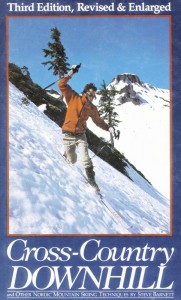
The book that turbo charged the tele revolution with the cover that defined the iconic image of telemarkers ever after.
On skinny skis it’s a pose that, while not recommended, is certainly inevitable. And yet I remember a day in the Sierra when we’d headed out late and the snow was eight inches of gloppy mush. The widest ski any of us had was maybe 63 millimeters at the waist. Fat for the time, but obviously not enough for any flotation. As long as the snow was consistent, we could figure out how to link turns, except when we hit a rotten patch. Then we simply augered in and rolled over. Not Barnett. His tracks told a story of serpentine synchronicity. So we watched to see what he did when he hit the rotten patches. Barnett agrees, keeping your hands low is the most stable position, yet when his tips started to dive, his hands went up and his tracks didn’t even wobble.
Since then, the changes in tele gear have all been towards making the downhill aspect stronger. Barnett calls it heavy telemark. Compared to what he began on, and for what he continues to use the majority of time, it absolutely is heavier. While Barnett doesn’t disparage the trend, he does lament it.
For Barnett, the touring aspect is supreme, because even when you’re turning, you’re still on the tour, you’re still moving. And mobility is the heart of it for Steve. Not many people have ever been up for walking 20 miles along a road to ski Mt. Olympus, but Barnett did, and for that sort of tour, today’s plastic tele boots don’t work. “Excursions might,” he admits, “but those are still kinda stiff.”
Steve isn’t blind to the necessity, or appropriateness of heavy telemark, stating plainly, “I won’t say anything bad about skis today except you need big boots to use ‘em.” It’s not like he doesn’t see the correlation and the benefit of bigger skis and bigger boots. In fact, ask him what the most influential piece of equipment was that catapulted telemark to it’s current popularity and he says unequivocally, “Oh, it was the boots by faaarrrrr,” dragging out the last r for emphasis, then adds, “by a mile.”
Is he surprised at the popularity of telemark today?
“No. When I wrote the book I was surprised then (1976) that so many people wanted to know, not necessarily about telemark, but they wanted to know the secret way to ski everywhere. I wrote the book because I thought, ‘this was the greatest thing ever’. I still do in a lot of ways.” So Barnett saw its popularity as more or less inevitable; the basic motivation remains the same – all those thousands of acres of pristine untracked snow surrounding every resort. Back then it was about combining cross-country mobility and downhill ability, for which telemark was the preferred turn.
“A lot of people say, ‘look how far we’ve come’,” says Barnett, “but it doesn’t look that way to me.” He knows that makes him sound like a curmudgeon, so he attempts to explain his perspective based on what attracted him to it in the first place.
For Barnett, there were a number of things: cost, simplicity, mobility, and safety. “It’s not cheaper than AT skiing, or more expensive, but pins used to be $10 at REI. When you add cables and release and all, it’s not simple anymore. You can’t hike any distance in the boots, they’re heavy and restrictive. I like complete freedom of ankle motion – fore and aft. And where’s the inherent safety? I think the more motion you have, the safer you are. Heavy telemark has the same limitation as alpine where you can rip your A.C.L. if you fall backward.”
“So if you look at the key features, it’s all been given up. In terms of touring, you’ve lost everything that made it attractive.”
Barnett practices what he promotes. His favorite touring rig? Glittertinds with Salomon BC boots and bindings.
“The step-in version,” he says pointedly. “Why not go for the holy grail, right?” he adds with trademark sarcasm.
What’s so great about Glittertinds?
“They can be made to turn beautifully through all kinds of cruddy snow. Even breakable crust, not just for a skinny ski (55mm waist), they do it well because their flex is so uniform. Keep in mind I’m skiing them short, only 190cm. I took them to an area and you don’t go bashing down things like you can with an RT-80, but with the right technique you can reliably make turns on just about anything.”
Therein, perhaps is the crux of Barnett’s lament. It isn’t that he doesn’t like the bigger equipment, it just doesn’t fit with his flavor of telemark because it puts more emphasis on technology than technique.
How important is technique? Barnett is quick to extol its virtues, “It’s better than buying equipment. Put the time in and then you’ve got it for life. And if you learn on softer equipment you will learn better because you actually have to do the technique, you can’t rely on the equipment to do it for you.”
Indeed, if you’re arcing telemark turns on 190cm skis with a 55mm waist using Salomon BC boots and bindings you better have some technique.
He gives an example of a snowboarder he met at a trailhead and they went on a tour together; Barnett on his Glittertind’s and the rider with his splitboard. At the summit the splitboarder said, “I absolutely must learn that telemark.” He bought a pair of Heli Stinx and some Asolo Snowfields and “he’s goin’ to town,” says Steve, then adds, “His snowboard skills are really helpful because he’s not afraid of falling. It takes about a month of a lot of crashes to learn to telemark.”
“I can see why a lot of people are chosing AT over telemark these days because heavy telemark doesn’t have any advantage.”
Again, Barnett is quick to recognize he doesn’t represent the majority. “Let me put a proviso on things,” he says. “I’m 63 now. So no matter what gear people are using, most are passing me. And no matter what gear they’re on, or what type of tour they’re doing, everybody has a good time. My own predeliction is for the skinny stuff and that’s where I see the future of telemark going because with the Glittertinds I telemark all of the time. With my RT-80s I only telemark some of the time.”
Though it is but one man’s perspective, it reveals much about how far tele is gone.
© 2011
A shorter, edited version of this profile first appeared in Telemark Skier magazine, #15.
Related Post
Interview with Steve Barnett – Nov. 2013 (in Polish)

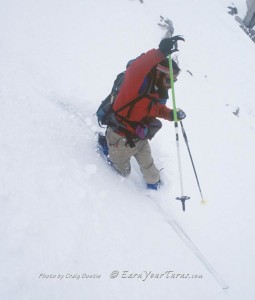
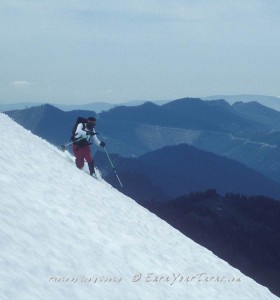

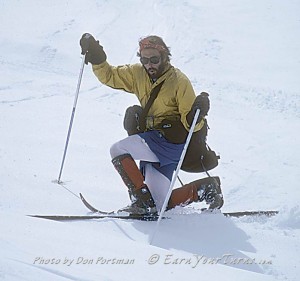
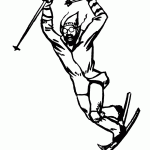
2 comments
2 pings
“they wanted to know the secret way to ski everywhere.”
That goes into my book of quoteables. Thanks Steve..again.
Thanks Craig for the write-up.
I think ageing does provoke rethinks. My rig is 3.6 kg per foot and I can punt all day as long as the skis stay on the snow and the grades aren’t too bad but if not, it’s possible to run out of puff.
[…] So what about the photo that we first showed you? We connected with Peter Stevens over on Flickr and he was telling us about Steve Barnett: […]
[…] Steve Barnett […]